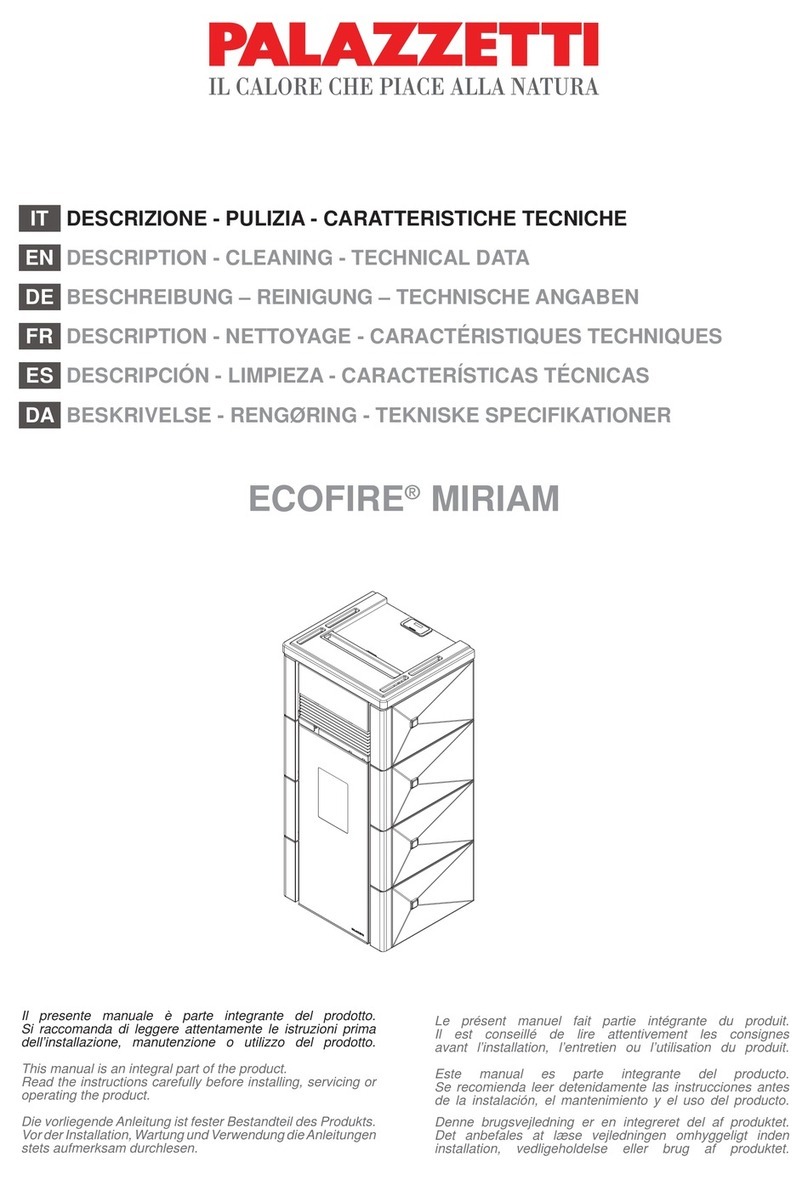
2
This manual describes the installation and operation of the U. S. Stove, 4840 wood heater. This heater meets the 2015 U.S.
Environmental protection agency’s crib wood emission limits for wood heaters sold after may 15, 2015. Under specific test conditions
this heater has been shown to deliver heat at rates ranging from 6,270 to 10,749 btu/hr.
IMPORTANT: Read this entire manual before installing and
operating this product. Failure to do so may result in property
damage, bodily injury, or even death. Proper installation of
this heater is crucial for safe and efficient operation. Never
use make-shift compromises during the installation.
Before installing your heater, you must perform an initial burn
in an OUTSIDE environment. Follow the Start-Up Procedure
in the Operation section of this manual.
This heater must be installed on an exterior wall to the outside.
Contact your local building officials to obtain a permit and
information on any additional installation restrictions or
inspection requirements in your area.
Save these instructions.. This manual has important operating
and maintenance instructions that you will need at a later time.
Always follow the instructions in this manual.
This heater is designed and approved for premium hardwood
pellet fuel only. Any other type of fuel burned in this heater
will void the warranty and safety listing.
Never use gasoline, gasoline-type lantern fuel, kerosene,
charcoal lighter fluid, or similar flammable liquids to start or
“freshen up” a fire in this heater. Keep all such liquids well
away from the heater while it is in use.
A working smoke detector must be installed in the same room
as this product.
Do not unplug the heater if you suspect a malfunction. Turn
the ON/OFF SWITCH to ”OFF’ and contact your dealer.
Do not operate your heater with the viewing or combustion
door open. The auger will not feed pellets under these
circumstances and a safety concern may arise from sparks or
fumes entering the room.
Never disable or bypass the safety devices in this unit. Doing
so could result in damage to the unit or endanger yourself or
someone else.
For noncatalytic models, the following statement— ‘‘This
wood heater needs periodic inspection and repair for proper
operation. It is against federal regulations to operate this wood
heater in a manner inconsistent with operating instructions in
this manual.
Never try to repair or replace any part of the heater unless
instructions for doing so are given in this manual. All other
work should be done by a trained technician.
Turn the heater OFF and allow to completely cool before
performing any maintenance.
Disconnect the power cord before performing any maintenance!
NOTE: Turning the ON/OFF Switch to ”OFF” does not
disconnect all power to the electrical components of the heater.
Ashes must be disposed in a metal container with a tight fitting
lid. The closed container of ashes should be placed on a non-
combustible surface or on the ground, well away from all
combustible materials, pending final disposal.
The exhaust system should be checked bi- monthly during the
burning season for any build-up of flyash, soot or creosote.
HOT WHILE IN OPERATION. KEEP CHILDREN
CLOTHING AND FURNITURE AWAY. CONTACT MAY
CAUSE SKIN BURNS. Do not touch the hot surfaces of
the heater. Educate all children on the dangers of a high-
temperature heater. Young children should be supervised when
they are in the same room as the heater.
A power surge protector is required. This unit must be plugged
into a 110 - 120V, 60 Hz grounded electrical outlet. Do not use
an adapter plug or sever the grounding plug. Do not route the
electrical cord over the heater. Do not route the cord in foot
traffic areas or pinch the cord under furniture.
The heater will not operate during a power outage. If a power
outage does occur, check the heater for smoke spillage and
open a window if any smoke spills into the room.
Never block free airflow through the open vents of the unit.
Keep foreign objects out of the hopper.
The moving parts of this heater are propelled by high torque
electric motors. Keep all body parts away from the auger
while the heater is plugged into an electrical outlet. These
moving parts may begin to move at any time while the heater
is plugged in.
Do not place clothing or other flammable items on or near
this heater.
WARNING—DO NOT INSTALL THIS UNIT IN A
SLEEPING ROOM. CAUTION—The structural integrity
of the mobile home floor, wall, and ceiling/roof must be
maintained.
This appliance is not intended for commercial use.
DO NOT INSTALL A FLUE DAMPER IN THE EXHAUST
VENTING SYSTEM OF THIS UNIT.
DO NOT CONNECT THIS UNIT TO A CHIMNEY FLUE
SERVING ANOTHER APPLIANCE.
DO NOT USE CHEMICALS OR FLUIDS TO START THE
FIRE; DO NOT BURN GARBAGE OR FLAMMABLE
FLUIDS SUCH AS GASOLINE, NAPHTHA OR ENGINE
OIL.
DO NOT CONNECT TO OR USE IN CONJUNCTION
WITH ANY AIR DISTRIBUTION DUCTWORK
UNLESS SPECIFICALLY APPROVED FOR SUCH
INSTALLATIONS.
The chimney connector shall not pass through an attic or roof
space, closet or similar concealed space, or a floor, or ceiling.
Where passage through a wall, or partition of combustible
construction is desired, the installation shall conform to
CAN/CSA-B365, Installation Code for Solid-Fuel-Burning
Appliances and Equipment.
SAFETY PRECAUTIONS



























